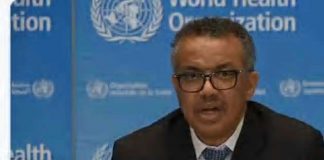APRIL 12, 2020
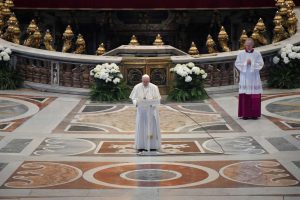
Pope Francis reads his “Urbi et Orbi” (“To the City and the World”) message in St. Peter’s Basilica with no public participation due to an outbreak of the coronavirus disease on Easter Sunday at the Vatican, April 12, 2020. – Vatican Media/Via Reuters
ROME, ITALY — It was a day of live-streamed Masses, of empty pews, of interrupted family rituals. Easter ceremonies went on, but they looked as they never have before, with coronavirus restrictions leading to the ban in many countries of large-scale gatherings, including at churches.
Some Christians around the world attended drive-in services. But for others, it was a day spent at home, praying behind closed doors, following Mass on television or on their computer. Governments have pleaded with people to stay indoors, stepping up enforcement over the holiday weekend.
“For many,” Pope Francis said, “this is an Easter of solitude lived amid the sorrow and hardship that the pandemic is causing.”
As in so many places, Easter in the Vatican was stripped down, more somber, with Francis speaking in a gaping and mostly-vacant St. Peter’s Basilica as church bells clanged across Rome. Gone were the usual markers of Easter in the city-state — the banners, the live bands, the tens of thousands of pilgrims, the rows of flowers that almost make St. Peter’s look like a garden.
Francis spoke this year in front of only a few dozen people, delivering an Urbi et Orbi — a special papal address — devoted to the pandemic. He talked about how the virus has “deprived” people of closeness, and said that “millions of lives” have suddenly changed. He spoke about the pandemic in geopolitical terms, praying for the end of hostilities and calling for political solidarity, especially in Europe. And, sounding a theme common throughout his papacy, he emphasized the vulnerability of the poor, the homeless, migrants and refugees, and “those living on the peripheries.”
“Let us ensure that they do not lack basic necessities — all the more difficult to find now that many businesses are closed — such as medicine and especially the possibility of adequate health care,” Francis said.
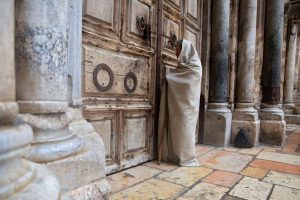
A worshiper stands at the closed door of the Church of the Holy Sepulchre in Jerusalem, Friday, April 10, 2020. – Sebastian Scheiner/AP
Jerusalem
The Easter dawn climbed the ancient stone walls of the Old City on Sunday as it has for two millennia; it was greeted with the iron peal of church bells as it has been for hundreds of years. But in a city that revers the unchanging return of ritual, almost nothing else was normal on this holiest of Christian holidays.
Where the murmur of prayers and hymns of joy would normally fill the narrow lanes, nothing could be heard but the coo of doves. The clinking steps of five armed Israeli police officers patrolling the Via Delarosa took the place of thousands of pilgrims who would normally ply the route of Jesus’s final Earthly walk on this weekend.
For some, the unprecedented quiet brought an unexpected blessing: a chance to strip the day to its spiritual core.
“There are less distractions,” said Peter Stavropoulos, a Greek Orthodox priest, only his eyes visible between his black face mask and his black kamilavka (head gear). “We are able to concentrate on our prayers.”
Signs in Hebrew, Greek and Arabic led almost no one to the Church of the Holy Sepulchre, built on the spot where Jesus was crucified, buried and resurrected, according to tradition. Easter morning is normally a time of mass congregation here, with believers from around the globe overflowing the cavernous gloom and filling the sunny plaza outside.
On this Easter, the plaza was all but empty. The towering wooden doors locked to a world frozen in quiet chaos.
Adeeb Joudeh, the latest of the Muslim family that has held the keys to the church for more than 800 years, said he unlocked the doors just after sunrise, not to admit the usual multitudes but just the Archbishop of the Latin Patriarchate and two priests, locking them in. Their unpeopled mass was live-streamed to the shut-in faithful.
“There has never been a holy day as sad,” Joudeh said.
And yet.
A lone worshiper stood at the closed doors, draped in a cloak, a palm frond in her hand, forehead resting on the wood, praying or perhaps feeling the vibrations of the organ just audible from the unreachable reverence within. She stood in for the millions who were remotely seeking solace on this most unsettled of Easters, and her presence alone seemed to fill an empty place with holiness.
Seoul
Scores of policemen and public officials surrounded the Sarang Jeil Church in Seoul on Easter Sunday. Angry members of the megachurch loudly accused the police of “offense against religious worship,” and shouted slogans saying, “we will hold Easter Sunday services.”
The 5,000-strong megachurch led by populist pastor Jun Kwang-hoon faces an assembly ban for violating mask requirements and social distancing rules, yet in the end, police stood aside as Easter services were held.
Since coronavirus clusters emerged from churches in the city, the Seoul government has enforced controls on Sunday services and warned of penalties for noncompliance. Last weekend, city officials found some 1,914 churches holding in-person worships, of which 18 violated the health rules.
Christianity is the biggest religion in South Korea with followers making up nearly 30 percent of the population. There are more than 6,000 churches in the capital city alone.
“Come what may, the Korean church cannot stop the worship but we turn to video services in face of the infectious disease,” the United Christian Churches of Korea chairman Kim Tae-young said in an Easter video message. Thousands of churches across the country, however, are still expected to hold Easter services in-person, even while others look alternatives like online sermons or drive-in services.
Nearly half of South Korea’s 10,512 virus cases are traced to Shincheonji Church of Jesus, which is not part of the umbrella group and considered a cult by mainstream Christian churches. The church’s messianic leader Lee Man-hee said all gatherings have been suspended since the outbreak, and publicly apologized for the church’s role in the national “calamity.”
“Many churches cut back on services and followers celebrated the resurrection of Jesus Christ at their homes,” said President Moon Jae-in. He expressed gratitude to the Korean church for the cooperation in his Easter message on Sunday.
By Min Joo Kim
Rome
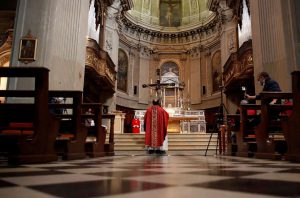
Priest Mario Carminati prays during the Passion of Christ Mass on Good Friday inside the Santissima Redentore church in Seriate, near Bergamo, one of the areas worst hit by coronavirus, Northern Italy, Friday, April 10, 2020. – Antonio Calanni/AP
Father Giulio Dellavite, 48, was one of the lucky few allowed into Bergamo’s main cathedral Sunday for Easter Mass. But this year, before leaving for church, he needed to sign government-mandated form, explaining his reasons for being on the road. He felt he needed to wear a mask and gloves. Then, after Mass, he planned to return to his residence for lunch with the other clerics — “the ones who are still here,” he said.
Perhaps no Catholic diocese in the world has been harder-hit by the virus than the one in Bergamo, Italy, where more than 20 priests have died in recent weeks, and where Easter has become as much a remembrance as a celebration.
One of the priests who died had lived in Dellavite’s residence, and three others are still in quarantine. For Easter lunch, the remaining clerics planed to gather in a large dining room.
“One person at each table,” Dellavite said. “respecting the rules that the government gave us.”
One of those priests is 97 years-old.
“[He] saw the wars, how history changed in Italy, and he said that this is the first time in his entire life that he cannot celebrate the Mass,” Dellavite said.
The outbreak in Italy, which has killed more than 19,000 people, has upended the lives of priests, putting them on the front lines of grief and mourning — and sometimes exposing them to the virus as well. One of the priests Dellavite knew well was Father Fausto Resmini, 67, a prison chaplain who also helped people reintegrate into the community after their release. Resmini died in late March of the virus. In normal times, he would have received a large funeral — but those gatherings, too, are banned.
Dellavite said that in recent weeks he has spoken with so many people who have lost loved ones, grieving without the rituals they are used to, and the emotion of that loss will spill into Easter. He called it a “real Easter,” with all the extraneous pomp stripped away.
“After all this pain,” he said, “people need life.”
By Chico Harlan and Claudia Cavaliere

A general view shows an empty church as a camera crew records a closed-door live broadcast of the Catholic mass to celebrate Palm Sunday at the Cathedral Basilica of the Holy Family in Nairobi, April 5, 2020. – Njeri Mwangi/Reuters
Nairobi
The Archbishop of Nyeri looked out on the flock that had gathered in the cavernous hall of downtown Nairobi’s Holy Family Basilica for Easter Mass.
Before him were 13 cameramen, two print journalists, a security guard, a quartet of choir singers, and another quartet — four talkative black birds, darting between the nooks of the cathedral’s soaring ceiling, making the only noise to interrupt Anthony Muheria’s echoing sermon.
There wasn’t a rustle of feet, nor a murmur of amens, nor an errant cellphone jangle. But Archbishop Muheria was speaking directly to Kenya’s Catholic faithful, in a way. He made sure to thank God for live-streaming.
“Coronavirus is not a joke,” he told his homebound parishioners, as cable networks and radio stations beamed the words to high-rise apartments, picturesque villages and crowded slums. “This is a life and death affair. If you cannot hug your loved ones to wish a happy Easter, send a text message hug.”
These days, Muheria absolves confessions through WhatsApp. When you call his phone, a ring-back tone plays gospel music. Instead of the collective solace of singing hymns together, filling the air of churches and nearly lifting the faithful off their feet, Kenyans Sunday sat in their rooms and sang by themselves.
While the coronavirus hasn’t devastated Kenya, it has prompted stringent and painful containment measures. Masks must be worn in public. Travel is largely banned. A dusk-to-dawn curfew is in effect. Police have enforced it brutally, killing and injuring dozens. A day before Easter, the government banned all unauthorized aid-giving after a stampede for food in a slum killed two.
Muheria used his pulpit to decry these injustices.
“Death for us in Kenya is almost a business. We thrive in calamity, but not in life,” he said. “What has hardened the hearts of us Kenyans that we cannot cry for our brothers and our sisters? As Jesus said, you must give half your meal portion to the poor — and not for the camera’s sake, for God’s! Can we learn to love each other again this Easter?”
By Max Bearak
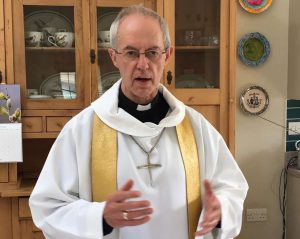
An image released by Lambeth Palace on April 12, 2020, shows Britain’s Archbishop of Canterbury Justin Welby as he records on his iPad, his Easter Sunday sermon from the kitchen of his flat in London. – Caroline Welby/Lambeth Palace/Afp Via Getty Image
London
On a normal Easter Sunday, Justin Welby presides at the Canterbury Cathedral in Kent, a soaring, sublime edifice, a thousand-year-old World Heritage Site, dating to the 11th century and the Norman Conquest.
On this Sunday, the Archbishop of Canterbury, leader of the Church of England, led services from his kitchen table in his London flat, via YouTube.
His wife Caroline serving beside him, you could see the couple’s cupboards and countertops.
The prerecorded video was basic cable, nothing fancy, but heartfelt. Welby fingered a match from a box and lit the Easter candle, a symbol of Christ’s resurrection, and he said the old words, “Alpha and Omega, all time belongs to him, and all ages…”
In his sermon, the archbishop spoke of suffering and death and light. He prayed for the prime minister and all others in hospital, and those who cared for the sick and grieved for the dead.
“Even in the dark days of this Easter we can feed on hope. We can dream of what our country and our world will look like after the pandemic,” Welby said.
“Once this epidemic is conquered here and elsewhere, we cannot be content to go back to what was before as if all was normal,” he said. “There needs to be a resurrection of our common life, a new normal, something that links to the old, but is different and more beautiful.”
In the chat scrolling alongside the streaming video, participants posted greetings of “Happy Easter!” with smiley-face emojis from all across Britain, and Japan, Australia, America. From Suffolk a viewer wrote: “Thankful for giving peace in this crazy time.”
Courtesy/Source: Washington Post








































































































